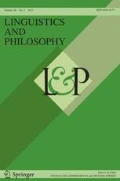Abstract
In this paper, I show that the availability of what some authors have called the weak reading and the strong reading of donkey sentences with relative clauses is systematically related to monotonicity properties of the determiner. The correlation is different from what has been observed in the literature in that it concerns not only right monotonicity, but also left monotonicity (persistence/antipersistence). I claim that the reading selected by a donkey sentence with a double monotone determiner is in fact the one that validates inference based on the left monotonicity of the determiner. This accounts for the lack of strong reading in donkey sentences with ↑ MON → determiners, which have been neglected in the literature. I consider the relevance of other natural forms of inference as well, but also suggest how monotonicity inference might play a central role in the actual process of interpretation. The formal theory is couched in dynamic predicate logic with generalized quantifiers.
Similar content being viewed by others
References
Barwise, J. and R. Cooper: 1981, ‘Generalized Quantifiers and Natural Language’,Linguistics and Philosophy 4, 159–219.
van Benthem, J.: 1986.Essays in Logical Semantics, Reidel, Dordrecht.
van Benthem, J.: 1987, ‘Meaning: Interpretation and Inference’,Synthese 73, 451–470.
Chierchia, G.: 1990, ‘Anaphora and Dynamic Logic’, ITLI Prepublication Series LP-90-07, Institute for Language, Logic and Information, University of Amsterdam.
Chierchia, G.: 1992, ‘Anaphora and Dynamic Binding’,Linguistics and Philosophy 15, 111–183.
Dekker, P.: 1993,Transsentential Meditations: Ups and Downs in Dynamic Semantics, dissertation, University of Amsterdam.
van Eijck, J. and F.-J. de Vries: 1992, ‘Dynamic Interpretation and Hoare Deduction’,Journal of Logic, Language and Information 1, 1–44.
Evans, G.: 1977, ‘Pronouns, Quantifiers and Relative Clauses (I)’,Canadian Journal of Philosophy 7. Reprinted with emendations in M. Platts (ed.),Reference, Truth and Reality, Routledge & Kegan Paul, London, 1980.
Gawron, M., J. Nerbonne, and S. Peters: 1991, ‘The Absorption Principle and E-Type Anaphora’, in J. Barwise et al. (eds.),Situation Theory and Its Applications, Vol. 2, CSLI Lecture Notes No. 26, CSLI, Stanford.
Geach, P. T.: 1962,Reference and Generality, Cornell University Press, Ithaca, NY (third edition, 1980).
Geach, P. T.: 1965, ‘On Complex Terms’,Journal of Philosophy 72. Reprinted inLogic Matters, University of California Press, Berkeley, 1980.
Groenendijk, J. and M. Stokhof: 1990, ‘Dynamic Montague Grammar’, in L. Kálmán and L. Pólos (eds.),Papers from the Second Symposium on Logic and Language, Akadémiai Kiadó, Budapest.
Groenendijk, J. and M. Stokhof: 1991, ‘Dynamic Predicate Logic’,Linguistics and Philosophy 14, 39–100.
Heim, I.: 1982,The Semantics of Definite and Indefinite Noun Phrases, Ph.D. dissertation, University of Massachusetts, Amherst.
Heim, I.: 1990, ‘E-Type Pronouns and Donkey Anaphora’,Linguistics and Philosophy 13, 137–177.
Kadmon, N.: 1987,On Unique and Non-unique Reference and Asymmetric Quantification, Ph.D. dissertation, University of Massachusetts, Amherst.
Kadmon, N.: 1990, ‘Uniqueness’,Linguistics and Philosophy 13, 273–324.
Kamp, H.: 1981, ‘A Theory of Truth and Semantic Representation’, in J. Groenendijk, T. M. V. Janssen, and M. Stokhof (eds.),Formal Methods in the Study of Language. Reprinted in J. Groenendijk, T. M. V. Janssen, and M. Stokhof (eds.),Truth, Interpretation, and Information, Foris, Dordrecht, 1984.
Kamp, H.: 1991, ‘Uniqueness Presuppositions and Plural Anaphora in DTT and DRT’, in M. Stokhof, J. Groenendijk, and D. Beaver (eds.),Quantification and Anaphora I, Edinburgh (DYANA deliverable R2.2A).
Kanazawa, M.: 1993, ‘Dynamic Generalized Quantifiers and Monotonicity’, ILLC Prepublication Series LP-93-02, Institute for Logic, Language and Computation, University of Amsterdam. Also to appear in M. Kanazawa and C. J. Piñón (eds.),Dynamics, Polarity, and Quantification, CSLI Lecture Notes, CSLI, Stanford.
Neale, S.: 1990,Descriptions, MIT Press, Cambridge, Mass.
Partee, B. H.: 1989, ‘Many Quantifiers’, inProceedings of ESCOL '88.
Rooth, M.: 1987, ‘Noun Phrase Interpretation in Montague Grammar, File Change Semantics, and Situation Semantics’, in P. Gardenfors (ed.),Generalized Quantifiers, Reidel, Dordrecht.
Schubert, L. K. and F. J. Pelletier: 1989, ‘Generically Speaking, or Using Discourse Representation Theory to Interpret Generics’, in G. Chierchia, B. H. Partee, and R. Turner (eds.),Properties, Types and Meaning II, Kluwer, Dordrecht.
de Swart, H.: 1991, ‘Quantification over Time’, in J. van der Does and J. van Eijck (eds.),Generalized Quantifier Theory and Applications, Dutch Network for Language, Logic and Information.
Westerståhl, D.: 1989, ‘Quantifiers in Formal and Natural Languages’, in D. Gabbay and F. Guenthner (eds.),Handbook of Philosophical Logic, Volume IV, Reidel, Dordrecht.
Author information
Authors and Affiliations
Additional information
I would like to thank the following people for their comments and/or judgments: Alessandro Zucchi, Stanley Peters, Charles Lee, Jane Aronson, Johan van Benthem, Peter Sells, Ivan Sag, Will Leben, Gillian Ramchand, Chris Piñón, Bill Poser, Dorit Ben-Shalom, Eric Jackson, David Beaver, Mary Dalrymple, Ray Flournoy, Mats Rooth, and Lynn Cherny, as well as the audiences at Stanford University and at UCLA.
Rights and permissions
About this article
Cite this article
Kanazawa, M. Weak vs. strong readings of donkey sentences and monotonicity inference in a dynamic setting. Linguist Philos 17, 109–158 (1994). https://doi.org/10.1007/BF00984775
Issue Date:
DOI: https://doi.org/10.1007/BF00984775




